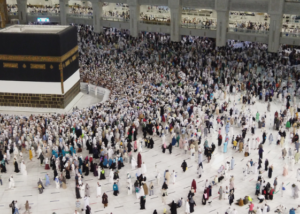Is meeting a non-Mahram in public Haram?
Quran
Hadith
Islamic Text
بِسْمِ اللَّهِ الرَّحْمَنِ الرَّحِيمِ
In the Name of Allah Most Merciful Most Kind
Short Answer
No, meeting a non-Mahram in public is not Haram because it is not prohibited seclusion (Khalwah). However, if it is a means of Fitnah (temptation) or undue free mixing then it may be Haram for that reason. In any case, it should only be done when there is a need or necessity.
Explanation
عَنْ أَنَسٍ، أَنَّ امْرَأَةً كَانَ فِي عَقْلِهَا شَيْءٌ، فَقَالَتْ: يَا رَسُولَ اللهِ إِنَّ لِي إِلَيْكَ حَاجَةً، فَقَالَ: يَا أُمَّ فُلَانٍ انْظُرِي أَيَّ السِّكَكِ شِئْتِ، حَتَّى أَقْضِيَ لَكِ حَاجَتَكِ. فَخَلَا مَعَهَا فِي بَعْضِ الطُّرُقِ، حَتَّى فَرَغَتْ مِنْ حَاجَتِهَا
(Sayidina) Anas reported that a woman, who was mentally unstable, said, O Messenger of Allah, I need your help. He ﷺ said: O Mother of so and so, select any pathway you would like, so that I may assist you. Then he ﷺ stood in seclusion with her at one of the pathways so that she got the assistance she required. (Sahih Muslim, 2326 – 76).
In the Sahih Hadith above, we see that the blessed Prophet ﷺ spoke to a lady who was a non-Mahram in public. However, the Hadith mentions that they were in seclusion. Meaning, there was a level of privacy. This is used as evidence that a form a seclusion with an unrelated member of the opposite gender is permitted. Specifically, it refers to a situation where people can see them but not hear what is being said.
The blessed Prophet ﷺ used the word al-Sikak (السِّكَكِ) in the Hadith. This word was explained by Imam Ibn Hajr al-Asqalani in his commentary on Sahih al-Bukhari. It refers to a pathway where people are usually walking through. This demonstrates that the likely presence of others is sufficient for permissibility.
وَهِيَ الطُّرُقُ الْمَسْلُوكَةُ الَّتِي لَا تَنْفَكُّ عَنْ مُرُورِ النَّاسِ غَالِبًا. (فتح الباري شرح صحيح البخاري)
They (al-Sikak) are oft-used pathways that are rarely free of passersby. (Imam Ibn Hajr, 852H, Fath al-Bari).
General prohibition
There is a general prohibition on seclusion (Khalwah) with a member of the opposite gender. Therefore, this particular Hadith narration does raise questions. Amongst them is the question of why was this permissible.
Further, the Hadith itself mentions the Prophet ﷺ was in seclusion with the lady. Imam al-Bukhari seemed to recognise this concern. Thus, he included it in his chapter heading. He also seemed to provide a clarification.
بَابُ مَا يَجُوزُ أَنْ يَخْلُوَ الرَّجُلُ بِالْمَرْأَةِ عِنْدَ النَّاسِ
Chapter on the permissibility of a man being secluded with a woman in the presence of others. (Sahih al-Bukhari).
As we can see from the above, Imam al-Bukhari mentioned seclusion in the presence of others, or in public. Thus, alluding to the fact that seclusion with a non-Mahram in public is permitted. Meaning that meeting and speaking privately with a member of the opposite gender is permitted if it is done in public.
أَيْ لَا يَخْلُو بِهَا بِحَيْثُ تَحْتَجِبُ أَشْخَاصُهُمَا عَنْهُمْ بَلْ بِحَيْثُ لَا يَسْمَعُونَ كَلَامَهُمَا إِذَا كَانَ بِمَا يُخَافِتُ بِهِ كَالشَّيْءِ الَّذِي تَسْتَحْيِ الْمَرْأَةُ مِنْ ذِكْرِهِ بَيْنَ النَّاسِ. (فتح الباري شرح صحيح البخاري)
Meaning, not to be alone with her in such a way that they are veiled from them. Rather, in a manner that they do not hear their words if it is something private. Such as something that a woman would be embarrassed to mention in the presence of people. (Imam Ahmad bin Ali bin Hajr al-Asqalani, 852H, Fath al-Bari).
خَلَا بِهَا بِحَيْثُ لَا يَسْمَعُ مَنْ حَضَرَ شَكْوَاهَا وَلَا مَا دَارَ بَيْنَهُمَا مِنَ الْكَلَامِ وَلِهَذَا سَمِعَ أَنَسٌ آخِرَ الْكَلَامِ فَنَقَلَهُ وَلَمْ يَنْقُلْ مَا دَارَ بَيْنَهُمَا لِأَنَّهُ لَمْ يَسْمَعْهُ. (فتح الباري شرح صحيح البخاري)
He was alone with her in such a way that no one present could hear her issue. Nor the specific conversation that took place between them. That is why (Sayidina) Anas heard the end of the conversation and transmitted it. But he did not convey the actual conversation since he did not hear it. (Imam Ahmad bin Ali bin Hajr al-Asqalani, 852H, Fath al-Bari).
In the Nusoos (texts) above, Imam Ibn Hajr al-Asqalani explains the nature of the seclusion that is permitted. It is permitted to meet a non-Mahram in public, such that others can see one. It is also permitted to have a private conversation, such that others cannot hear it. Of course, all of this is only acceptable in situations of need or necessity.
Hanafi Imams
حَاصِلَه أَن الرجل الْأمين لَيْسَ عَلَيْهِ بَأْس إِذا خلا بِامْرَأَة فِي نَاحيَة من النَّاس لما تسأله عَن بواطن أمرهَا فِي دينهَا وَغير ذَلِك من أمورها، وَلَيْسَ المُرَاد من قَوْله: (أَن يَخْلُو الرجل) أَن يغيب عَن أبصار النَّاس، فَلذَلِك قَيده بقوله: (عِنْد النَّاس) وَإِنَّمَا يَخْلُو بهَا حَيْثُ لَا يسمع الَّذِي بالحضرة كَلَامهَا وَلَا شكواها إِلَيْهِ. (عمدة القاري شرح صحيح البخاري)
In conclusion, an honest man is not discredited by being secluded with a woman at some distance from people. So that she can tell him about details regarding her religion and other concerns. His saying: A man be secluded, does not mean that he disappears from the sight of people. Which is why he restricted it by saying: in the presence of people. Rather he is only alone with her, such that those present cannot hear her speech nor her concerns being conveyed to him. (Imam Badr al-Deen al-Ayni, 855H, Umdatu al-Qari).
In the Nass above, Imam Badr al-Deen al-Ayni provides details regarding the permissibility of meeting a non-Mahram in public. He explains that people should be present, but they do not have to hear the conversation for the meeting to be permitted.
وَفِيهِ تَنْبِيهٌ عَلَى أَنَّ الْخَلْوَةَ مَعَ الْمَرْأَةِ فِي زُقَاقٍ لَيْسَ مِنْ بَابِ الْخَلْوَةِ مَعَهَا فِي بَيْتٍ عَلَى احْتِمَالِ أَنَّ بَعْضَ الْأَصْحَابِ كَانُوا وَاقِفِينَ بَعِيدًا عَنْهُمَا مُرَاعَاةً لِحُسْنِ الْأَدَبِ. (مرقاة المفاتيح شرح مشكاة المصابيح)
In it is clarification that being alone with a woman in a pathway is not the same as seclusion with her in a house. Given the possibility that some of the companions were standing at a distance. Thus, observing the best of etiquette. (Imam Ali al-Qari, 1014H, Mirqaat al-Mafateeh).
Pragmatism
It would be best for a female to speak to other females when she requires religious advice or guidance. However, that is not always possible. Sometimes a male scholar may be better suited to assist or the only qualified person available. In such circumstances, the Shariah has provided guidance on how to carry out the consultation.
They must not be in seclusion such that no person could see them. As for the conversation itself, it is correct to keep it completely private and confidential. In this manner, the need is fulfilled without causing undue Fitnah or doubt.
وَفِيه تَعْلِيم الْأمة وَكَيْفِيَّة الْخلْوَة بِالْمَرْأَةِ. (عمدة القاري شرح صحيح البخاري)
In it (the Hadith) is instruction to the Ummah (nation) regarding how to be in seclusion with a woman. (Imam Badr al-Deen al-Ayni, 855H, Umdatu al-Qari).
Conclusion
Meeting a non-Mahram in public is permitted. However, there are conditions that must be fulfilled for permissibility to be established. Also, it should only be done when there is a need or necessity. As Muslims we do not deem unduly mixing with the opposite gender permissible. However, interaction is permitted when required.
When there is a requirement and there is no fear of Fitnah (temptation) or undue free mixing then seclusion with the opposite gender is permitted. This seclusion refers to a situation where the conversation is private but they are in a public setting.
And Allah Most High Knows Best.
–Answered by Shaykh Noorud-deen Rashid (15.05.24)






